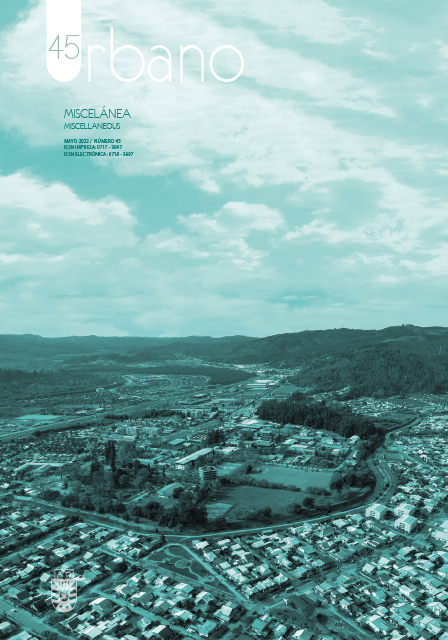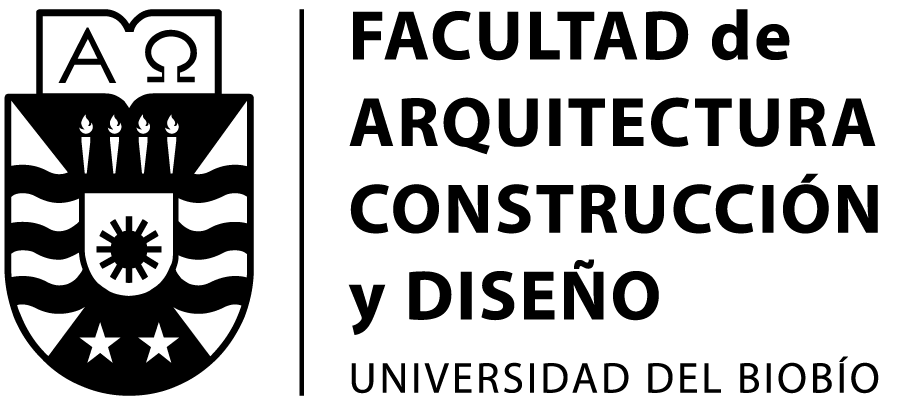Analysis of urban structures in a company town. Beginning, development, and decline of the “New Camp” case, Chuquicamata
DOI:
https://doi.org/10.22320/07183607.2022.25.45.08Keywords:
urban structure, company town, obsolescence, industrial heritageAbstract
This research addresses the analysis of the different historical periods of Chuquicamata’s “New Camp”, in the Region of Antofagasta, looking closely at the evolution of its urban structure from the inception, development, and decline of the copper camp. Its purpose is to analyze the mutations of the built urban space, characterizing the interactions and meeting places of the Company Town residents , with the characterization of the different historical periods of Chuquicamata. For this, a literature review is carried out, and urban planimetric material is developed and collected from the different historical stages. Among the main conclusions, the process of decline is illustrated by comparing the mutations of the urban space in the different historical stages of the copper camp, analyzing the prioritization phenomenon of a production system, and the economic growth at the expense of residential well-being and living conditions.
Downloads
References
ASTORGA, P. (2011). Representación social de Codelco Chuquicamata y la definición de un discurso hegemónico en torno a su actuar: mirada laboral y comunitaria. Recuperado de https://repositorio.uchile.cl/handle/2250/144818
BEATTY, C. y FOTHERGILL, S. (1996). Labour market adjustment in a reas of chronic industrial decline: the case of the UK coalfields. Regional Studies, 30(7), 627-640.
CAMAGNI, R. (2005). Economía Urbana. Barcelona: Antoni Bosh.
CANO, J. M. (2012). Babel en la mina. El campamento minero como modelo de asentamiento en el mundo industrializado: Cerro Muriano (Córdoba). Munibe Antropologia-Arkeologia, (63), 321-343.
CAPUTO, O. y GALARCE, G. (2008). La nacionalización del cobre por Salvador Allende y la desnacionalización del cobre en dictadura y en gobiernos de la Concertación. CEME, 16. Recuperado de http://www.archivochile.com/Ideas_Autores/caputoo/caputolo0065.pdf
CERDA, G. y PUENTES, Y. (2019). Industrial heritage: The residential complex of the crav sugar factory in Penco, 1941-1975. Revista INVI, 34(96), 153–181. DOI: https://doi.org/10.4067/s0718-83582019000200153
CISTERNAS, L. (2015). Habitar un Company Town. Los campamentos de Coya, Caletones y Sewell entre 1922 y 1944. Santiago: Universidad de Chile.
Consejo de Monumentos Nacionales de Chile (2000). Definición de categorías de monumentos. CMN-Chile. Recuperado de https://www.monumentos.gob.cl/monumentos/definicion#:~:text=El patrimonio cultural se entiende,practicas y formas de vida.&text=Monumentos Históricos.
DAUMAS, J.C. (2006). L’usine, la mémoire et l’histoire. En Daumas, J.C. (Dir.), La mémoire de l’industrie (pp. 9–20). Besançon: Presses universitaires de Franche-Comté.
DAVIET, S. 2005. Industrie, culture, territoire. París: L’Harmattan.
DINIUS, O. y VERGARA, A. (2011). Company Towns in the Americas. Landscape, Power, and Working-Class Communities. Athens: University of Georgia Press.
FERNÁNDEZ, A. (1982). Langreo: industria, población y desarrollo urbano. Langreo: Ayuntamiento de Langreo.
GARCÉS, E. (2003). Las ciudades del cobre. Del campamento de montaña al hotel minero como variaciones de la Company Town. Eure, 29(88), 131–148. DOI: https://doi.org/10.4067/s0250-71612003008800006
GARCÉS, E. (2019). Las ciudades del cobre y las variaciones de la Company Town. Journal of Chemical Information and Modeling, 53(9), 1689–1699.
GARCÉS, E., O’BRIEN, J. y COOPER, M. (2010). Del asentamiento minero al espacio continental Chuquicamata (Chile) y la contribución de la minería a la configuración del territorio y el desarrollo social y económico de la región de Antofagasta durante el siglo XX. Eure, 36(107), 93–108. DOI: https://doi.org/10.4067/s0250-71612010000100005
GARCÍA BLANCO, J.M. y GUTIÉRREZ, R. (1988). El declive industrial en las cuencas mineras asturianas: una aproximación sociológica. Ábaco. Revista de Ciencias Sociales, 4 (2ª época), 51-62.
GARRIDO, S. (2018). Evolución de la huelga en la Gran Minería del Cobre 1911-1991. Revista Perfiles Económicos, (2), 131–162. DOI: https://doi.org/10.22370/rpe.2016.2.1207
GUTIÉRREZ-VIÑUALES, A. (2008). Chuquicamata: patrimonio industrial de la minería del cobre en Chile. Apuntes: Revista de Estudios Sobre Patrimonio Cultural, 21(1), 74–91.
ICOMOS (2003). Carta de Nizhny Tagil sobre el patrimonio industrial. Asamblea Nacional del TICCIH. Recuperado de http://www.international.icomos.org/18thapril/2006/nizhny-tagil-charter-sp.pdf
JURICIC, B. (2011). Historia Hospital “Roy H. Glover” de Chuquicamata. Biblioteca Ministerio de Salud. Recuperado de http://www.bibliotecaminsal.cl/wp/wp-content/uploads/2011/09/Historia-Hospital-Roy-H-Glover-de-Chuquicamata.pdf
LAVANDERO, J., FREI, C. y NÚÑEZ, R. (s.f.). Historia política y tributaria del cobre en Chile (Anexos). Biblioteca del Congreso Nacional. Chile.
LAYUNO, M. (2012). La problemática de la valoración y recuperación del patrimonio y el paisaje industrial rural. El caso de las minas de plata de Hiendelaencina (Guadalajara, España). Apuntes: Revista de Estudios Sobre Patrimonio Cultural, 25(2), 304–321.
LYON, C. (2014). Place systems and social resilience: a framework for understanding place in social adaptation, resilience, and transformation. Society & Natural Resources, 27(10), 1009-1023.
MAYORGA, E. (2004). Sueño de una integración patrimonial o el traslado de Chuquicamata a Calama. Urbano, 7(10), 4–8. Recuperado de http://revistas.ubiobio.cl/index.php/RU/article/view/518
MÉNDEZ, M., PRIETO, M. y GALAZ-MANDAKOVIC, D. (2020). Tele-production of miningscapes in the open-pit era: The case of low-grade copper, Bingham Canyon, US and Chuquicamata, Chile (1903–1923). The Extractive Industries and Society, 8(4), 1-12. DOI: https://doi.org/10.1016/j.exis.2020.10.013
MÉNDEZ, R. (2012). Ciudades y metáforas: sobre el concepto de resiliencia urbana. Ciudad y Territorio. Estudios Territoriales, 44(172), 215–232. Recuperado de http://www.fomento.gob.es/NR/rdonlyres/FF63AECF-CF4B-4A59-968B-D9B701ACA03B/113205/CyTET172.pdf
PRADA-TRIGO, J. (2011). Desarrollo, patrimonio y políticas de revitalización en ciudades intermedias de especialización minero-industrial. Oviedo: Consejo Económico y social de Asturias.
RODRÍGUEZ, J., MIRANDA, P. y MEDINA, P. (2012). Culturas mineras y proyectos vitales en ciudades del carbón, del nitrato y del cobre en Chile. Chungará (Arica), 44(1), 145-162. DOI: http://dx.doi.org/10.4067/S0717-73562012000100011
SÁNCHEZ-MORAL, S., MÉNDEZ, R. y PRADA-TRIGO, J. (2015). Resurgent cities: local strategies and institutional networks to counteract shrinkage in Avilés (Spain). European Planning Studies, 23(1), 33-52.
SÁNCHEZ-MONTAÑÉS, B. y CASTILLA, M. V. (2020). Fábricas de resiliencia: una oportunidad para el patrimonio industrial: el caso de La Trinidad. ACE: Architecture, City and Environment, 15(43), 9192. DOI: http://dx.doi.org/10.5821/ace.15.43.9192
SILVA, N. J. (2013). Patrimonio industrial en tierra cruda: la salitrera de María Elena, un modelo constructivo mixto. DigitAR-Revista Digital de Arqueologia, Arquitectura e Artes, (1), 22-31.
SOLÁ-MORALES, M. (1997). Formas de crecimiento urbano. Barcelona: Ediciones UPC.
VILCHES, V. (2018). Chuquicamata. Evolución de la vivienda en el campamento nuevo. Concepción: Viviana Vilches Wolf.
ZAPATA, F. (1975). Los mineros de Chuquicamata: ¿productores o proletarios? Cuadernos del Centro de Estudios Sociológicos. Ciudad de México. Colegio de México.
Downloads
Published
How to Cite
Issue
Section
License
Copyright (c) 2022 Fabiola Olivares-Contreras, José Prada-Trigo, Leonel Ramos Santibañez

This work is licensed under a Creative Commons Attribution-ShareAlike 4.0 International License.
The content of articles which are published in each edition of Habitat Sustentable, is the exclusive responsibility of the author(s) and does not necessarily represent the thinking or compromise the opinion of University of the Bio-Bio.
The author(s) conserve their copyright and guarantee to the journal, the right of first publication of their work. This will simultaneously be subject to the Creative Commons Recognition License CC BY-SA, which allows others to share-copy, transform or create new materials from this work for non-commercial purposes, as long as they recognize authorship and the first publication in this journal, and its new creations are under a license with the same terms.![]()























